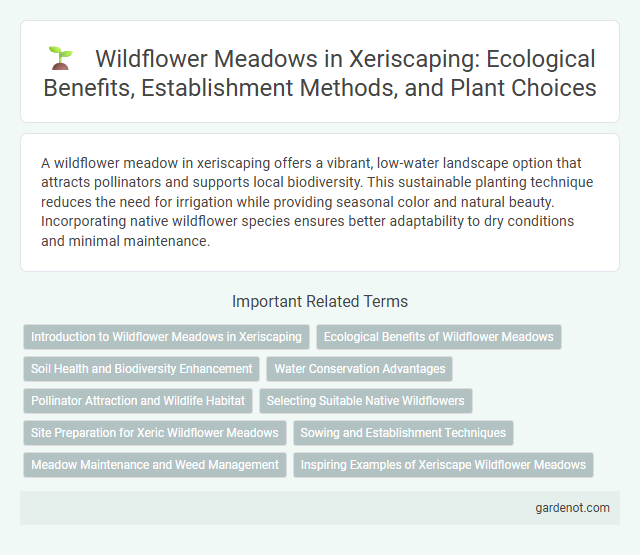A wildflower meadow in xeriscaping offers a vibrant, low-water landscape option that attracts pollinators and supports local biodiversity. This sustainable planting technique reduces the need for irrigation while providing seasonal color and natural beauty. Incorporating native wildflower species ensures better adaptability to dry conditions and minimal maintenance.
Introduction to Wildflower Meadows in Xeriscaping
Wildflower meadows in xeriscaping provide a sustainable and visually stunning option for low-water landscapes by incorporating native, drought-tolerant plants that thrive with minimal irrigation. These meadows support local biodiversity by attracting pollinators like bees, butterflies, and birds, while reducing maintenance and water usage compared to traditional lawns. Selecting region-specific wildflower species ensures adaptability and long-term ecological balance in xeriscape gardens.
Ecological Benefits of Wildflower Meadows
Wildflower meadows contribute significantly to biodiversity by providing essential habitats for native pollinators, birds, and insects, enhancing overall ecosystem resilience. These meadows improve soil health through deep-rooted plants that prevent erosion and increase water infiltration, supporting sustainable water management in xeriscaping. Their native plant species also promote carbon sequestration, aiding in climate regulation while requiring minimal irrigation compared to traditional lawns.
Soil Health and Biodiversity Enhancement
Wildflower meadows in xeriscape landscapes improve soil health by increasing organic matter and promoting beneficial microbial activity. Diverse native plant roots stabilize soil structure, reduce erosion, and enhance water infiltration, optimizing moisture retention in arid environments. This biodiversity-rich habitat supports pollinators, birds, and insects, fostering an interconnected ecosystem while minimizing water usage.
Water Conservation Advantages
Wildflower meadows require significantly less water compared to traditional lawns, reducing irrigation needs by up to 75%. Their deep-rooted native plants improve soil moisture retention and promote natural groundwater recharge. This water-efficient landscaping choice supports sustainable gardening practices while conserving valuable water resources.
Pollinator Attraction and Wildlife Habitat
Wildflower meadows in xeriscaping create vibrant pollinator habitats by supporting native bee, butterfly, and hummingbird populations with diverse nectar sources. These meadows enhance local biodiversity, providing essential shelter and breeding grounds for birds, small mammals, and beneficial insects. Integrating drought-tolerant wildflowers conserves water while sustaining critical ecological networks.
Selecting Suitable Native Wildflowers
Selecting suitable native wildflowers for a xeriscape wildflower meadow ensures optimal water efficiency and ecological harmony. Species such as Echinacea purpurea, Gaillardia pulchella, and Coreopsis tinctoria thrive with minimal irrigation and support local pollinators. Prioritizing drought-tolerant, region-specific varieties enhances soil health while reducing maintenance requirements in xeriscape designs.
Site Preparation for Xeric Wildflower Meadows
Preparing a site for a xeric wildflower meadow involves thorough soil assessment to ensure proper drainage and nutrient levels compatible with drought-tolerant species. Clearing invasive plants and minimizing soil disturbance helps maintain the natural seedbed structure essential for wildflower establishment. Incorporating organic mulch and grading the land to prevent water pooling supports the sustainable growth of native wildflowers in xeriscape landscapes.
Sowing and Establishment Techniques
Sowing wildflower meadow seeds requires precise soil preparation, including light raking and removing competing vegetation to ensure optimal seed-to-soil contact. Applying seeds evenly at the recommended rate, followed by gentle rolling or pressing, enhances germination success and establishment. Maintaining consistent moisture through careful watering during early growth stages is critical to support seedling development and long-term meadow vitality.
Meadow Maintenance and Weed Management
Wildflower meadow maintenance requires regular monitoring to ensure native species thrive and invasive weeds are minimized. Effective weed management includes timely mowing, targeted hand weeding, and the use of mulch to suppress unwanted growth. Consistent care promotes biodiversity and sustains the health of xeriscape landscapes.
Inspiring Examples of Xeriscape Wildflower Meadows
Xeriscape wildflower meadows showcase drought-resistant native species such as California poppies, black-eyed Susans, and purple coneflowers, thriving with minimal water input. These landscapes enhance biodiversity by providing habitat for pollinators like bees and butterflies, promoting ecological balance in arid environments. By incorporating mulch and efficient drip irrigation, xeriscape meadows reduce water consumption while maintaining vibrant, colorful displays throughout the growing season.
Wildflower meadow Infographic

 gardenot.com
gardenot.com